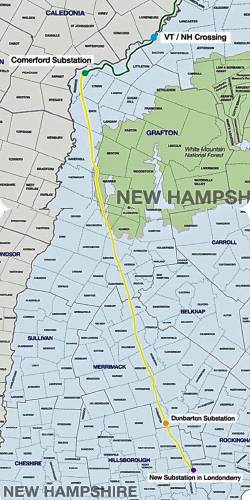When four representatives of National Grid came before Concord City Council on Monday to start the long process of expanding a power line through the state bringing electricity from HydroQuebec, they soon encountered a ghost.
“Our community still suffers from PTSD with regard to Northern Pass,” Councilor Jennifer Kretovic told them. “When you mention the words HydroQuebec, that will automatically raise concern.”
The four representatives nodded glumly.
Northern Pass, as most people in New Hampshire recall, was a decade-long effort by Eversource to build a power line through the state, including Concord, that would have brought a Seabrook Station’s worth of electricity down from massive dams in Quebec. The plan was canceled in 2017 after years of opposition from locals concerned about the damage created by new towers, power lines and rights of way, including a new corridor into the White Mountain National Forest. The opposition was also fueled by lobbying from competing utilities.
Now National Grid is proposing a similar project to connect New Hampshire with HydroQuebec, spurred by the possibility of hefty federal support. But they’re quick to say that it’s not really all that similar.
“Unlike previous attempts to bring in more transmission and hydropower from Quebec, our project does not require any new rights of way,” said Terron Hill, director for the project called Twin States Clean Energy Link, during Monday’s presentation to the council. That point was repeated several times during the half-hour talk.
Monday’s presentation was one of many that National Grid will be giving to communities in the two states. They will be asking for letters of support from Concord and other communities as they compete for a slice of the $2.5 billion Transmission Facilitation Program, a federal project to strengthen the nation’s power grid.
Twin State Clean Energy Link is competing with eight other large transmission proposals in the program, with winners likely to be announced this fall. Under the program, as explained at the meeting, the Department of Energy would buy a portion of the power, acting as an “anchor tenant” to remove some of the financial risk. It’s not clear whether National Grid would go forward if it does not succeed in its bid.
Support the Concord Monitor. Subscribe Today
The line barely affects Concord, cutting through about 2 miles in the city’s northwest corner after coming down through Salisbury and Webster then continuing through Hopkinton and Dunbarton. National Grid says Concord could earn $75,000 a year in extra property taxes if it is built.
In the region, as in much of New Hampshire, the line would use a transmission corridor built in the mid-1980s with three towers that carries more than 1,000 megawatts of hydropower from Quebec to Londonderry, where it enters the New England grid.
National Grid says it can carry an extra 1,200 megawatts along the corridor mostly by upgrading existing wires and using technology improvements, although it will have to increase the height of “about 30%” of the towers along the way, said Jessica Farrell, lead engineer for the project. The increase would occur on the two smaller 230-kilovolt towers, about 60 feet tall, built on either side of the central high-voltage 450-kilovolt DC towers that are 110 feet tall. The two towers could be raised an extra 5 to 30 feet, because higher voltage needs to be further from the ground for safety reasons, and in no case would end up as tall as the central tower, Farrell said.
Where the power lines don’t use existing towers and rights of way in Vermont and New Hampshire, National Grid says, they will be buried under state roads. That includes New Hampshire Route 135 between Dalton on the Connecticut River and Monroe, at which point the route would hook into a high-voltage transmission corridor that has existed for four decades.
National Grid says it can carry an extra 1,200 megawatts along the corridor mostly by upgrading existing wires and using technology improvements, an example of what is called “rewiring” to increase the carrying capacity of existing transmission corridors.
Adding more hydropower to the Northeastern power grid has long been advocated for environmental and cost reasons, since electricity made by dams is cleaner and often cheaper than electricity made by fuel-burning plants.
One difference between Northern Pass and Twin States is that the new proposal would be bi-directional, allowing electricity to be sent up to Quebec and sold if the situation arises such as if solar and wind power surges during a time of low demand in New England.


 Return to the Concord Monitor
Return to the Concord Monitor
The Northern Pass proposal was also bi-directional, which Northeast Utilities (now Eversource) didn’t advertise. However, this information was buried on the 26th page of the 172 page 2009 Annual Report of NU. They didn’t even call it the Northern Pass project:
“HQ Tie Line Project
NU and NSTAR, a major Massachusetts utility that serves the greater Boston area, are jointly planning a new, participant-funded, high voltage direct current transmission line from New Hampshire to Canada (HQ tie line project) where it will interconnect with a transmission line being planned by Hydro-Québec (HQ), a large Canadian utility. Under the proposed arrangement, NU and NSTAR would sell to HQ 1,200 MW of firm electric transmission service over the HQ tie line project in order for HQ to sell and deliver this same amount of firm electric power from Canadian low-carbon energy resources to New England. FERC granted approval of the HQ tie line project structure in May 2009.”
In short, we would have had to provide 1200 MW of almost all fossil fuel/nuclear power to Canada in return for their hydropower.
The reason is simple: demand in Quebec peaks in the winter, for electric heating. Here, it peaks in the summer, for cooling. It would have been a win-win for the power companies, but not for the environment. The current proposal shares the problem.